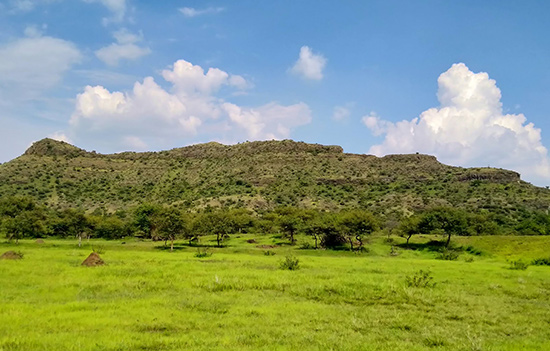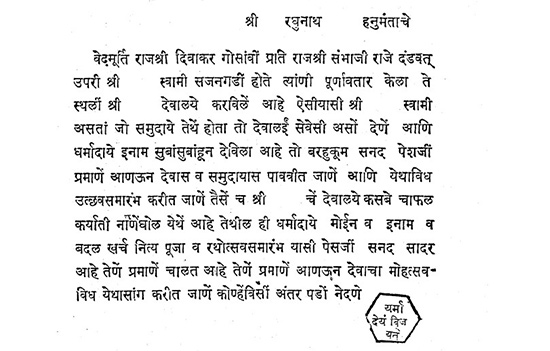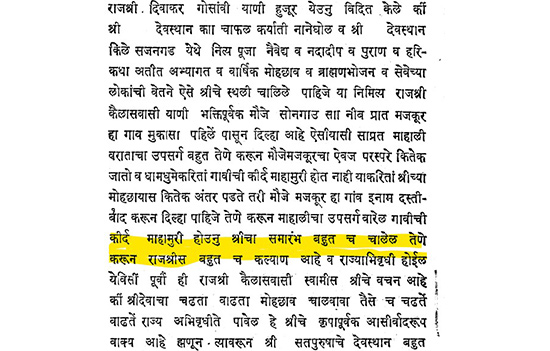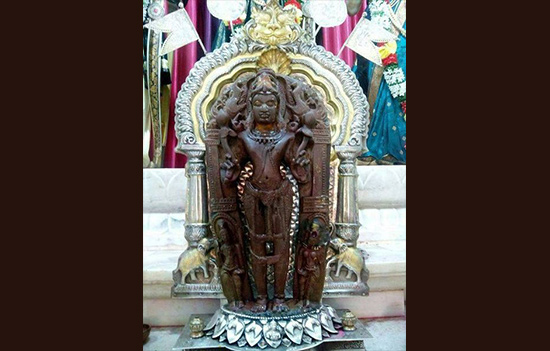- This
article deals with the association of Rishi Valmiki with Maharashtra, incidents
of Ramayan in Maharashtra and explores Maratha attempts at the revival of Hindu
Tirthkshetras including Ayodhya.
This
article primarily deals with the association of Rishi Valmiki with Maharashtra,
various incidents of Ramayan in Maharashtra, and Ram upasana of Kings in early
and medieval Maharashtra. This article also tries to explore the Maratha
attempts at the revival of Hindu Tirthkshetras including Ayodhya.
Legend of Rishi Valmiki’s association with Maharashtra
According
to Uttar Kand of Ramayana (This book narrates what happened after Shri Ram
returned to Ayodhya after the killing of Ravan), Valmiki was the tenth son of
Varun Dev (Prachet). (Ramayan Uttar Kand- Chapter 96, Shlok 18, Chatruvedi Dwarka
Prasad).
However,
according to Vaishakh Mahatmya of Skand Purana, Valmiki was a Vyadh (hunter) in
his earlier birth. He came in contact with Shankh Rishi and became a devout
person. Due to his devotion, in the next birth, he was born as Agni Sharma or
Ratnakara in a Brahmin family but due to his previous karmas, he was soon
separated from his father in a forest. He was later raised by a robber couple
and in his youth, worked as a hunter and robber, looting the travelers entering
a forest path. (This description is not meant to offend Rishi Valmiki or his
followers today. My apologies in advance). After every robbery was committed,
he used to drop a small stone in a pot to keep the count.
The Valhe village (56km from Pune) was known as the place where the Ratnakar met Devarshi Narad (or Saptarshi’s- Seven Rishi according to some legends). The hill near the village is still known as Saat Ranjan (Seven Pots) hill. After meeting them, the life of Ratnakar changed completely, he performed penance by chanting the Ram Nam. During his sadhana for over a thousand years, an ant hill was formed around his body. Upon completion of his sadhana, Devarshi paid a visit to open the ant hill. Since the reformed Ratnakar emerged from Valmik (Sanskrit for an ant hill), he was renamed Sage Valmiki. Rishi Valmiki composed the Ramayan on the orders of Rishi Narada and Brahmdeva, and Valmiki Ramayan is considered the contemporary literary source of Prabhu Shri Ram. (Valmiki Ramayan-Chapter 4, Shlok 1) Source
 Saat Ranjan hill. Pic by Suresh Isave.
Saat Ranjan hill. Pic by Suresh Isave.
Important events of Ramayan happened in modern day Maharashtra like his
staying at Dandak Van (Dandak Forest) including places known as Ramtek, cutting
the nose of Shuparnakha (Nashik), and the kidnapping of Devi Sita by Ravan
(Panchvati, near Nashik).
Ram Upasana/ Titles in the early
period of Maharashtra
Satvahanas
ruled from the 2nd to the 3rd Century CE. In the Nashik stone
inscription wherein King Vasishitiputra Pulumavi describes his father King
Gautamiputra Satkarni as valorous as Prabhu Shri Ram. (V V Mirashi- Satvahan
and Western Kshtrap-Inscription 18, Page 45)
Vakatakas
who were ruling in parts of Maharashtra from 3rd to 5th
CE were primarily devotees of Bhagwan Shiva but Prabhavati Gupta, the Chief Queen
of Rudrasena II was a devotee of Shri Ram. Rudrasena II was ruling from
Nandivardhan (Now Nagardhan, Nagpur District). For his wife Prabhavati, he
built a beautiful Ram Mandir at a place known as Ramgiri (Ramtek, Nagpur
District).
Pravarsena
II, the son of Rudrasena II shifted his capital from Nandivardhan to Pravarpur
(now Pavnar (Vardha District, Maharashtra), it was difficult for Queen Prabhavati
to visit the Ramgiri for her nitya puja. Hence Pravarsena II built another
temple of Prabhu Ram for his mother Prabhavati at Pravarpur. (VV Mirashi,
Vakatak-104-06). The remains of this grand temple were found in the Vinoba
Ashram of Pavnar.
During
the 13th Century, the Shri Ram temple which was built at Ramtek was rebuilt
by Devigiri Yadav Kings like Singhandev and Ramdev. (Nagpur Prantacha Itihas-
Y.M. Kale-9)
Revival of Ram upasana in 17th
Century Maharashtra
Ramdas
Swami (born as Narayan Thosar-1608) was credited with the revival of Ram upsana
in Maharashtra. After completion of his Ramjapa at Takli (near Nashik), Samarth
Ramdas traveled across India and founded multiple mathas (Akhara/monastery) in
major Indian pilgrimage centers.
He
was of the opinion that saints must actively engage the population rather than
remain aloof from society and prepare the populace to throw out the invaders. Since
Hanumanji is considered the epitome of strength, he founded Hanuman temples
with akharas (traditional gyms in
India) to inculcate the youth with religious and nationalistic thought.
When and where Chhatrapati Shivaji and Samarth Ramdas met is a different subject but it can’t be denied that Samarth Ramdas had a special influence on the Chhatrapati. In 1676, Chhatrapati Shivaji ordered the fort commander of Parli to receive Samarth Ramdas and his disciples at the fort. Due to the stay of Samarth Ramdas, the name of Parali was changed to Sajjangad (Fort of Righteous Person).
Bhimraj Swami or Meru Swami, one of Swami’s disciples moved to Tanjavur where King Vyankoji, the step-brother of Chhatrapati Shivaji founded his kingdom. Samarth Ramdas founded 6 mathas (monasteries)
at Tanjavur five of which are still functioning. The Thanjavur coat of arm
shows the influence of Samarth Ramdas and Ram upasana on the kings.
 Thanjavur coat of arms
Thanjavur coat of arms
After the death of Samarth Ramdas in 1682, his samadhi and Ram temple at Sajjangad were regularly patronized by the successive Chhatrapati. A letter from Chhatrapati Rajaram confirms the grant of a village in the firm belief that his devotion to Shri Ram and Ramdas swami at Sajjangad will help him to expand the state even in the tough times of Aurangzeb’s invasion.
 Letter of Chhatrapati Sambhaji.
Letter of Chhatrapati Sambhaji.
 Letter of Maharani Yesubai.
Letter of Maharani Yesubai.
 Letter of Chhatrapati Rajaram.
Letter of Chhatrapati Rajaram.
Raghuji Bhosale
 Raghuji Bhosale 1st, Senasaheb Subha. Pic courtesy Nagpur
Pranthacha Itihas by Y M Kale.
Raghuji Bhosale 1st, Senasaheb Subha. Pic courtesy Nagpur
Pranthacha Itihas by Y M Kale.
When the young Shahu Maharaj was released from the Mughal custody by Azam in 1707, he started his march towards Maharashtra to reclaim his throne. Parsoji Bhosale from the Hingni branch of Bhosale family was one of the earliest supporters of Shahu Maharaj. He was active from the time of Chhatrapati Shivaji and had received the title of ‘Senasaheb Subha’ (The commander of forces in the province) from Chhatrapati Rajaram.
Due to his unconditional support, at his coronation, Shahu Maharaj continued the title of ‘Senasaheb Subha’ of Parsoji and allotted him the areas of Varhad and Gondvan for the collection of Chauthai. (Nagpur Prantacha Itihas-Y.M. Kale, Pg 44-45). After the death of Parsoji, his son Kanhoji became Senasaheb Subha but soon he left Chhatrapati Shahu due to a feud and tried to join Nizam, Chhatrapati Shahu deputed Kanhoji’s adopted son Raghuji Bhosale against him.
Raghuji
Bhosale was born to Bimbaji Bhosale and his wife Kashibai who were disciples of
a Brahmin named Ramajipant Kolhatkar from Wai. When a child was born after many
years of their marriage, they believed it was a boon of this learned Brahmin,
hence they named the child Raghuji (Raghu clan in which Shri Ram was born).
During
the expansion of the Maratha domains in the Varhad, Raghuji visited the old Ram
temple at Ramigiri (Ramtek). Here he took a Navas
(a vow to a god often involving the promise of an offering in return for a
request granted) that if he became successful in his campaign, he would rebuild
the Shri Ram temple at Ramtek. After the successful completion of the campaign
at Devgad and making Nagpur his capital, Raghuji rebuilt the Shri Ram of
Ramtek. (Nagpur Prantacha Itihas- Y.M. Kale-73)
The
Kuldevta of Bhosales was Mahadev, but Raghuji also started Ram upasana. When he
went to Karnataka for a campaign, he received a vigraha (murty) of Prabhu Ramchandra (most probably from Thanjavur matha founded by Samarth Ramdas). With the permission of Chhatrapati Shahu, he kept the Saffron flag and Zaripatka (Zar-Gold i.e. a flag woven with golden threads) as a symbol of his authority (Nagpur Prantacha Itihas- Y.M. Kale-105) His every letter used to start with the word ‘Seetakant’ (the word is derived from two words Seeta and Kant- meaning husband of, which means Shri Ram).
Maratha attempts to revive the
Tirthkshetras
In
1719, Marathas got involved in Delhi Politics due to an invitation from the
Sayyid brothers and Raja Ajit Singh of Marwar, but this attempt was limited to
deposing Farrukhsiyar and placing the puppet king Rafi-ud-Darjat and later
Rafi-ud-Daulah (retitled Shah Jahan II). Through this puppet King, Marathas
under Peshwa Balaji Vishwanath and Senapati Khanderao Dabhade were able to
obtain the release of Maharani Yesubai, recognition of Chhatrapati Shahu as the
sovereign Maratha King and right to collect Chauth from the Six Deccan
provinces. Source
However, the first serious attempt to get a firm footing beyond Narmada started under legendary Bajirao Peshwa during the 1730s. The old Maratha-Bundela pact was put to a test in 1729 when Mohammad Bangash attacked the octogenarian Maharaja Chhatrasal. He wrote a letter of help and the Bajirao planned his Bundelkhan campaign. With the Maratha's help, Maharaja Chhatrasal defeated Mohammad Bangash.
The
timely help was repaid by Maharaja Chhatrasal when he portioned his kingdom into
three parts, two for his sons and a third for Bajirao. This portion in Central India
with areas such as Kalpi, Jhansi, Sagar, and Gadhakota became a firm base for
future Maratha operations in northern parts of India. (Marathi Riyasat-madhyvibhag
1- Sardesai- 342)
The much-publicized pilgrimage of Radhabai (Bajirao’s mother) in 1735 to various Tirthkshetras (holy sites) like Nathdwara, Mathura, Varanasi, and Prayag was not only a religious statement but also a politico-military statement about the growing Maratha power in north India. Not only Maharana of Udaipur and Maharaja Sawai Jai Singh who were on friendlier terms with the Marathas assisted her in the pilgrimage but even Mohammad Bangash provided her with an armed escort. It may look surprising that a staunch foe of Bajirao assisting his enemy’s mother for a pilgrimage but this condition has arisen only after Bangash was beaten by Marathas. It was a pragmatic decision of Bangash to facilitate Radhabai’s pilgrimage rather than inviting the wrath of the Marathas. This opened floodgates and with the Maratha assistance the revival of Tirthkshetras and restarting of pilgrimage, especially from Deccan picked up speed.
Narayan
Dixit Patankar, an influential Brahmin from Maharashtra settled in Kashi became
one of the chief facilitators for pilgrims and reconstruction of temples and
ghats. Reference
The
gradual liberation of Malwa in Central India by the Marathas set alarm bells
ringing in the Mughal camp. Though Sawai Jai Singh and Khan Dauran agreed to
cede Malwa to the Marathas, Sadat Khan (Awadh Governor) another staunch foe of
the Marathas, consistently opposed this view and advocated to resist Maratha
expansion. Muhammad Shah appointed Sadat Khan and Nizam Asaf Jaha I to check
the northward Maratha expansion. Not only did Bajirao outwit both of them and attack
Delhi in 1737 but also defeated Nizam Asaf Jaha I at the Battle of Bhopal in
early 1738, which resulted in the ceding of Malwa to the Marathas.
After
the death of Sadat Khan in 1739, his place was taken over by his nephew Mirza
Muhammad Mukim, better known as Mansur Khan Safdar Jang (Lion of Battle).
(First two Nawabs of Awadh-A.S. Srivastava-85, 90).
From
1743, Malharrao was planning to build the Kashi-Vishwanath temple by pulling down the mosque but Safdar Jang who was in charge of the area terrified the Kashi residents ‘that whoever will help the Marathas would be slaughtered’. Hence the plan was kept on hold by Malharrao. Reference
The Political Landscape of North India
in the mid 18th century
Before
moving further, we need to know the Political Landscape of the era. The major
Hindu holy places like Mathura, Gokul, and Vrindavan were in the domain of a
Hindu King i.e. Surajmal Jat. Kashi, Gaya, Prayag, and Ayodhya were under the
Subha of Prayag and Awadh respectively under Mohammad Bangash and Safdar Jang. Out
of these later Tirthkshetras, Marathas had already started the revival of Kashi
in the decade of the 1740s, though, at this point, they were not militarily in
control of these places.
After Nadir Shah was assassinated (1747), his capable Afghan captain Abdali became independent and declared himself King. His primary target of expansion was the rich province of Punjab. His constant attack on Punjab despite initial reversals reignited the hopes of Rohila-Pathans who were migrants from Afghanistan. They started supporting Abdali against the Mughal King which prompted Safdar Jang as a Vazir to eliminate this potential threat. But after his forces were defeated in the Battle of Farrukhabad and Kasganj, Safdar Jang’s position became critical (end-1750). The Rohila-Pathan armies had laid waste to the areas under Safdar Jang including the Hindu holy cities of Kashi. Reference
Safdar Jang called for Maratha's help, Malharao Holkar and Jayappa Shinde rushed to his help on the orders of Peshwa Nanasaheb. On multiple fronts including the Battle of Kadirganj, Maratha forces defeated the Pathans and relieved Safdar Jang (1751). The objective of the Marathas was political domination as well as liberating the important Hindu religious places.
As
mentioned earlier, Malharrao thought that since Safdar Jang has become a
friend, we could fulfill the long-cherished dream of restoration of the
original Kashi-Vishvanath temple. However, the Hindu population of Kashi who
had recently been at the receiving end of the marauding Pathans realized that
Marathas had not yet built their strength to protect them in case of further
Muslim attacks. Hence, they requested Malharrao and Peshwa to desist from this.
(Sardesai 363)
The Maratha domination in Delhi Politics and their attempts at the
revival of Hindu Tirthkshetra alarmed one of the most influential Islamic
preacher Shah Wali Ullah Dehlavi. The Islamic possession of Hindu holy places was a long-standing prestige of conquest (New History of the Marathas-Sardesai-364). Shah Wali Ullah and Najib-ud-daulah, the Rohila chief made most of this situation and a call to ‘holy war’ was given.
Abdali’s invasions after 1756 had this brutal religious fervor, where the Hindu holy places of Mathura and Vrindavan were desecrated despite the stout resistance of Antaji Mankeshwar (Maratha envoy in Delhi) and Jawahir Singh (son of King Surajmal Jat). Similarly, Amritsar the holiest Sikh place was also desecrated by Abdali’s army. The issue was so contentious that even Safdar Jang and later his son Shuja-ud-doula (considered on friendlier terms with the Marathas after the latter’s help in the 1751 Pathan war) were also uncompromising on this point.
Apart from the ‘prestige of conquest’ sentiment, there was a strategic issue involved in the handover of Ayodhya to the Marathas. Awadh Nawab’s capital Faizabad was in very close proximity to Ayodhya (6km). Shuja rightly feared that once Marathas occupied Ayodhya under the garb of liberating religious places, it would be very difficult to dislodge them from this position and it would be a constant source of worry for him. Though neither Safdar Jang nor Shuja flatly refused the handover of Tirthkshetras, they kept on delaying the matter by giving excuses one after the other. Reference
In 1757 when Marathas marched against Abdali and reached Attock, Nanasaheb Peshwa ordered Dattaji Shinde to now move towards the Eastern part of India to clear up the debt of the Maratha Empire. Najib used this episode to amplify Shuja’s fear that once he (Najib) is lost, the next target of the Marathas would be Shuja even though Marathas had saved Safdar Jang by crushing the Pathans in 1751. By sending military help to Najib at a critical moment during the Battle of Shukratal (1759), Shuja considered his survival first. This same mindset helped Najib to turn Shuja to Abdali’s camp in 1760 despite Maratha's promises making him Vazir at Delhi.
After
the loss at Panipat, Marathas were not in a position to dominate Delhi affairs
for nearly a decade, creating a vacuum, which was then exploited by the British
East India Company.
 Shri Ram temple of Chafal.
Shri Ram temple of Chafal.
Devi Ahilyabai Holkar and Shri Ayodhya
कुरुक्षेत्रतीर्थे तुलादानमेवं सुवर्णा रौप्यदिकं वारंवारम I
अहिल्यापि स संददो दानशीला धरादेवताभ्यो गुणज्ञानशीला II
अयोध्या, मथुरा, गया, कांची, काशीस्थ ब्राह्मणानं I
पुष्करस्थान कुरुक्षेत्र द्वारिकाश्रित भूसुरान II
Translation: The donations given at the
Kurukshetra (by the kings before the war of Mahabharata) by Tuladan (the
tradition of giving donations equivalent to your weight) like gold and silver.
Similarly, Devi Ahilya is donating to Gods and knowledgeable Brahmins in this
yuga.
Sapt
Puris
(Seven holy cities) like Ayodhya, Mathura, Gaya, Kanchi, Kashi as well as
Pushkar, Kurukshetra, and Dwaraka she (Maharani Ahilyabai) is giving donations
to learned Brahmins - From Ahilyakamadhenu
by Khushaliram Bhat (Holkar Riayasaticha Sanskrutik Itihas-Page 84-90)
Even
after this episode, Marathas had tried to revive the Ayodhya by a combination
of Diplomacy and muscle power. Maharani Ahilybai Holkar (daughter-in-law of
Malharrao Holkar) had sent agents to many of the religious places to rebuild
the demolished or dilapidated temples. The records of the Holkar family throw
light on the extent of these efforts across the length and breadth of
India.
At
Ayodhya Dham, Ahilyabai developed/ donated to the
following temples/shrines including Shri Ram Mandir, Sharayudwar, Shri
Treta Ram Mandir, Shri Bhairav Mandir, Shri Nageshwar Mandir, along with Shri
Sharayu Ghat on Sharayu River, Dharmashala (living quarters for pilgrims) and
Annachhatra (free food for pilgrims). (Holkar
Riayasaticha Sanskrutik Itihas-Page 95)
To read all
articles by author
To read all
articles on Maratha history